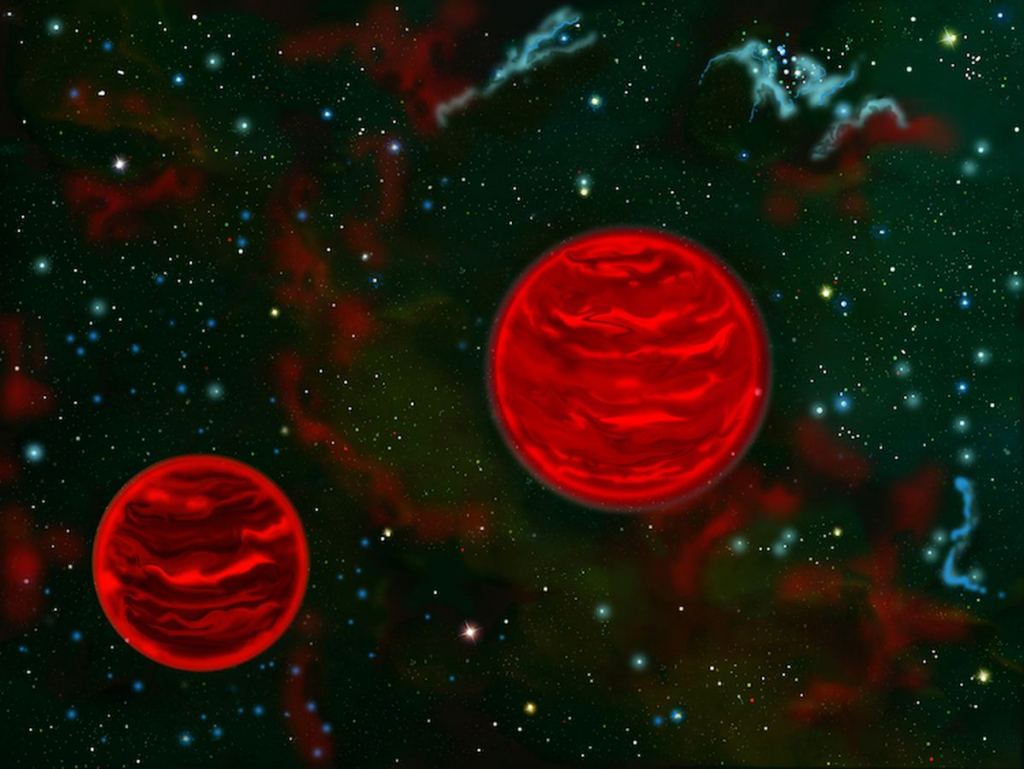Radio Telescope Confirms Free-Floating Binary Planets in the Orion Nebula
By Evan Gough
Planets orbit stars. That’s axiomatic. Or at least it was until astronomers started finding rogue planets, also called free-floating planets (FFPs). Some of these planets were torn from their stars’ gravitational grip and now drift through the cosmos, untethered to any star. Others formed in isolation.
Now, astronomers have discovered that some FFPs can orbit each other in binary relationships as if swapping their star for another rogue planet.
In 2023, astronomers working with the James Webb Space Telescope (JWST) detected 42 JuMBOs in the inner Orion Nebula and the Trapezium Cluster. JuMBOs are different than other free-floating planets. They’re Jupiter-Mass Binary ObjectS.
“The existence of these wide free-floating planetary-mass binaries was unexpected in our current theories of star and planet formation.”
From “A Radio Counterpart to a Jupiter-mass Binary Object in Orion,” by Rodriquez et al. 2024.
In that research, the JWST performed a near-infrared survey of the region with its powerful NIRCam. It looked at powerful outflows and jets from young stars, ionized circumstellar disks, and other objects in the region. Among the findings were the 42 JuMBOs. “Further papers will examine those discoveries and others in more detail,” the authors of that paper wrote.

That’s exactly what’s happened. New research published in The Astrophysical Journal Letters examines one of the JuMBOs in more detail. But instead of infrared observations, the authors used observations from the Karl G. Jansky Very Large Array (VLA) to examine the objects in radio emissions.
The paper is “A Radio Counterpart to a Jupiter-mass Binary Object in Orion.” The lead author is Luis Rodriguez, a researcher at the Instituto de Radioastronomía y Astrofísica, Universidad Nacional Autónoma de México.
“The existence of these wide free-floating planetary-mass binaries was unexpected in our current theories of star and planet formation,” Rodriguez and his colleagues write in their paper. “These systems are not associated with stars, and their components have masses of giant Jupiter-like planets and separations in the plane of the sky of order about 100 au.”
Our understanding of planets and how they form starts with stars. Stars form in giant molecular clouds, and as they form, a rotating disk of gas and dust forms around the star. Planets form in these disks, and they take up residence in orbit around the star.
But rogue planets, also called Isolated Planetary Mass Objects (IPMOs), can form differently. Currently, there are two competing explanations for their formation. They may form around stars as described above, or they may form in isolation like low-mass stars and brown dwarfs do.
The JuMBOs range from 0.6–14 Jupiter masses, and they’re between 28 and 384 AU apart. There’s currently no explanation for how these binary objects can form. Solitary rogue planets are compatible with our understanding of how stars and planetary systems form. But JuMBOs don’t fit inside that understanding.
These objects have things in common with brown dwarfs, sub-stellar objects more massive than the largest planets yet too small to trigger fusion. Brown dwarfs can be found at wide separations in binary pairs. Astronomers found one brown dwarf pair separated by 240 AU, and there are likely more widely separated brown dwarf binaries yet to be discovered.
In this paper, the researchers examined one particular JuMBO from the previous study called JuMBO 24. They looked at VLA observations that spanned a decade and found that JuMBO 24 was far brighter in radio luminosity than brown dwarfs.
The research team naturally wondered if the radio sources they detected were coming from JuMBO 24. By working their way through the data, they concluded that it’s highly unlikely that the radio emissions are coming from a source other than JuMBO 24. The odds of the radio emissions and the infrared emissions detected by JWST coming from separate sources is only 1 in 10,000, according to the researchers.

The objects most similar to JuMBOs in terms of their radio emissions are the ultracool dwarfs. But JuMBO 24 doesn’t exhibit the same patterns in radio emissions that ultracool dwarfs do. “The radio emission appears to be steady at a level of about 50 millijanskys over timescales of days and years,” the authors point out, while emissions from ultracool dwarfs have greater variability. That means that JuMBO 24 is the first detected centimetre continuum source with a planetary-mass binary object.
“The radio emission is marginally resolved in the same direction as the infrared source detected by JWST, suggesting that the radio emission comes from a combination of the two planetary-mass objects,” the researchers write in their conclusion. For now, the mechanism responsible for the radio emissions is a mystery. “Additional radio observations are necessary to pin down the nature of the radio emission mechanism,” the team concludes.
For lead author Rodriguez, there’s more to this discovery than just the unexplained radio emissions and what the discovery means for our understanding of how planets can form. These binary planets on ultra-wide orbits around each other could host moons that are potential abodes of life.
“What’s truly remarkable is that these objects could have moons similar to Europa or Enceladus, both of which have underground oceans of liquid water that could support life,” he stated.
The post Radio Telescope Confirms Free-Floating Binary Planets in the Orion Nebula appeared first on Universe Today.

February 15, 2024 at 02:09AM
via Universe Today read more...

Post a Comment